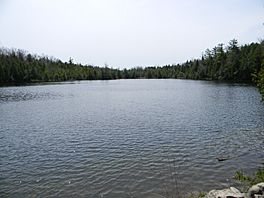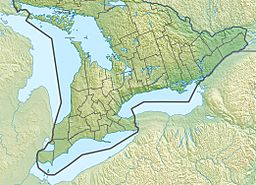Crawford Lake (Halton Region) facts for kids
Quick facts for kids Crawford Lake |
|
|---|---|
 |
|
| Location | Regional Municipality of Halton, Ontario |
| Coordinates | 43°28′05″N 79°56′55″W / 43.46806°N 79.94861°W |
| Type | Meromictic |
| Primary inflows | Unnamed creek |
| Basin countries | Canada |
| Max. length | 270 m (886 ft) |
| Max. width | 130 m (427 ft) |
| Surface area | 2.4 ha (5.9 acres) |
| Max. depth | 22.5 m (74 ft) |
| Surface elevation | 286 m (938 ft) |
Crawford Lake is a special lake located near Campbellville in the town of Milton, Ontario, Canada. It's part of the Crawford Lake Conservation Area, which is a protected natural space. This area is so important that it's recognized as an Area of Natural and Scientific Interest and is even part of the Niagara Escarpment World Biosphere Reserve.
A small, unnamed creek flows into Crawford Lake, keeping its waters fresh.
Contents
What Makes Crawford Lake Special?
Crawford Lake is a unique type of lake called a meromictic lake. This means its layers of water don't mix together. Usually, lakes mix their water from top to bottom, especially in spring and fall. But in a meromictic lake, the bottom layer stays separate and undisturbed.
Nature's Time Capsule: Varves
Because the water layers don't mix, tiny bits of sediment (like mud and plant pieces) settle to the bottom in clear layers each year. These layers are called varves. Think of them like the rings inside a tree trunk, but for a lake! Each varve tells us about a specific year in the lake's history.
These varves are super helpful for scientists. They allow researchers to accurately date things found in the lake's sediment. This makes Crawford Lake a perfect spot for studying history and the environment.
Reading Nature's Diary: Pollen and History
Scientists use something called pollen analysis to study the past at Crawford Lake. They look at tiny pollen grains trapped in the varves. Different plants produce different types of pollen. By identifying the pollen in each layer, scientists can figure out what plants were growing in the area hundreds of years ago.
This "pollen diary" has helped us learn a lot about the native Iroquoian Indians who lived here long ago. It showed that they were farming in the area even before Europeans arrived.
Reconstructing an Ancient Village
Thanks to many years of hard work by archaeologists, old historical records, and stories passed down by First Nations people, a Wendat-Huron village has been rebuilt in the conservation area. This reconstruction helps visitors imagine what life was like for the people who lived by Crawford Lake centuries ago.
Uncovering Environmental Secrets
Scientists also study the chemicals found in the lake's sediment layers. This is called geochemical analysis. It helps them understand how the environment has changed over time. For example, by looking at these chemical clues, researchers have been able to trace how air pollution has increased and where it came from over the last 150 years. This shows how human activities have impacted the area around Crawford Lake.


